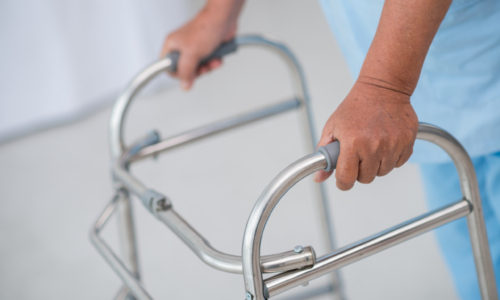Home Safety and adaptations with GBM – Tips & Tricks from a PT
Author: Barbara Marcus, Physical therapist
As a caregiver to someone with GBM the multitude of tasks can be physically, emotionally, socially and financially demanding. Caregivers are challenged to solve problems and make decisions as care needs change with the progression of the disease. As an Occupational Therapist I was able to navigate these changes and make adaptations for my husband to keep him safe as his cognitive and physical functions declined. Of utmost importance to us was to preserve his quality of life and dignity while maintaining as much independence as possible.
There are options for inpatient rehabilitation, out patient rehabilitation or home care therapy. Over the course of our journey we used all of these options. Physical therapists helped with balance and strengthening exercises, Occupational therapists focused on support with activities of daily living, and Speech therapists assisted with strategies for organization, word retrieval, and planning. Home modifications adapt living spaces to increase use, safety, security and independence. The options are endless and dependent on both the physical setting, needs of the individual, resources, and motivation.
Handrails or grab bars provide something to hold onto in the shower, next to a toilet, near a step as balance diminishes. When properly installed they also provide an aid for standing and sitting. Suction grab bars can be used on glass but need to be checked daily as they can loosen.
Walking/ mobility aids can progress from a standard cane, four prong cane, walker, to a wheelchair.
An electric stair lift enabled us to stay in our home because the living area was one flight up from the garage entrance. I had a ramp built inside the house so that he could get from the car to the stair lift without walking.
A large faced digital clock substituted for the watch when vision and time management was compromised.
A baby monitor allowed me to be in a different room and always be accessible when he was in bed. As his voice became weak I would have been unable to hear a call for help from another room.
A shower chair with arms became a necessity as standing and balance became challenging.
Medical alert systems are used for fall detection when home alone. Choices range from a lanyard around the neck, clip on, or watch. There are many companies with a variety of options
A hospital bed allows for easier position changes and safer transfers in and out of bed
A bedside commode may be needed if mobility is significantly challenged.
Simple changes like removing scatter rugs, rearranging furniture, writing down directions, using a paper calendar, or removing clutter can make it easier to move around.
Elastic waist pants, shirts without buttons, tube socks, or slip on shoes may support independence or make it easier for a caretaker to assist with dressing.
Expectations, roles and responsibilities of family members, friends and caretakers change and can be unpredictable. This can be overwhelming so don’t be afraid to ask for help. PT’s or OT’s can do a home visit or video chat to make recommendations. Sometimes trial and error is handy to see what works for you. Everyone’s home is different so be creative and problem solve.





